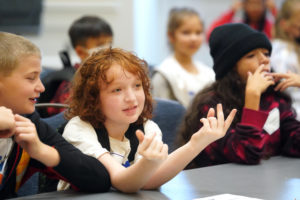Elephant toothpaste. The giant glob of sudsy foam created in a classroom experiment gave Battlefield Elementary School student Aidan Muller a thought: “Chemistry is cool!”

The whimsical tooth wash – hydrogen peroxide mixed with dish soap and a healthy dose of imagination – was part of a fall field trip designed to get students excited about STEM subjects (science, technology, engineering and math) and educators comfortable with teaching them. Third- through fifth-graders in Spotsylvania County Public Schools’ Rising Scholars program swept through the University of Mary Washington, soaking up lessons on aquatic plants and outer space, and having up-close encounters with robots.
“It’s a unique opportunity for these students to learn about real-world solutions being developed by scientists,” said Michael Clark, director of academic engagement for the Chief Technology Office of the Naval Surface Warfare Center Dahlgren Division, which brought the robots to UMW’s Fredericksburg campus.
The base partnered with Mary Washington’s College of Education, and departments of biology, chemistry and physics, to host the elementary-school entourage – from 16 public schools – on an exploration of topics, from kinetics to cosmology, and how the arts and humanities can tie them together.
Assistant Professor of Education Melissa Wells taught “Experiencing STEM Through the Arts,” combining principles of geology and dance. Covering concepts like weathering and erosion, Wells asked students to use their bodies to illustrate qualities of rocks – hard, heavy, sharp, smooth. “When we’re creative that means that we try different things and solve problems in different ways,” she said.
Professor of Physics and Astronomy Matt Fleenor taught “Cosmology and You.” Participants used balloons to explore the dynamics of volume and pressure, and how they relate to outer space. “I learned that the universe is future, past, known and unknown,” said Spotsylvania Elementary School student Blake Bishop.
Senior Lecturer of Biology Michael Stebar offered “Double Double Toil and Trouble,” focusing on photosynthesis. Students peered through microscopes to understand how the aquatic plant Cabomba produces oxygen. And Associate Professor of Chemistry Leanna Giancarlo shared the elephant toothpaste scenario, “Kinetics Chemistry,” where participants investigated reaction rates.

For “Evolution of Robotics,” NSWCDD scientists and engineers hauled actual military models –used for everything from above-ground explosive searches to underwater reconnaissance missions – into the Cedric Rucker University Center’s Chandler Ballroom. An exercise that asked students to provide precise instructions for building a peanut butter and jelly sandwich gave them a taste of the types of clear and deliberate commands needed to code these machines.
“What they were learning about – STEM activities, science experiments and robotics – ties into our curriculum, and we wanted to see it in action,” said Brock Road Elementary School teacher Tammy Irwin. Plus, “It’s great to expose the kids to college. It gets them thinking about the future.”



